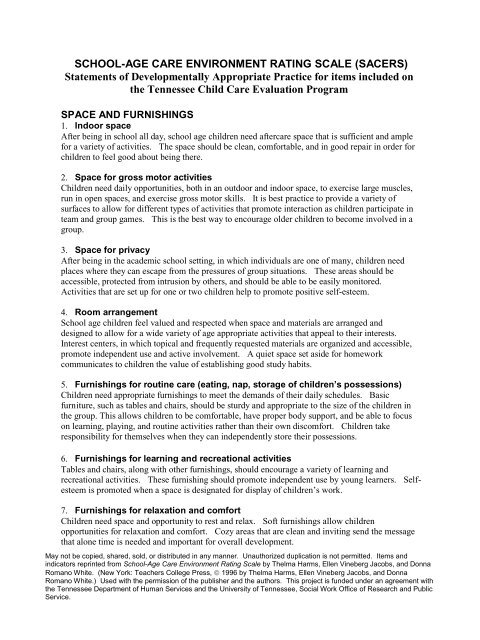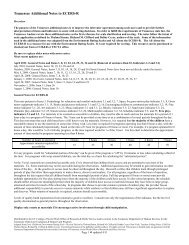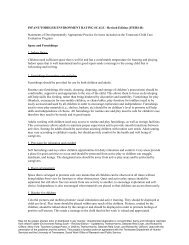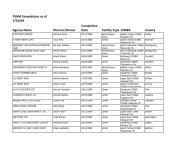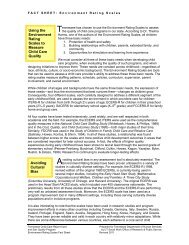SCHOOL-AGE CARE ENVIRONMENT RATING SCALE (SACERS ...
SCHOOL-AGE CARE ENVIRONMENT RATING SCALE (SACERS ...
SCHOOL-AGE CARE ENVIRONMENT RATING SCALE (SACERS ...
- TAGS
- rating
You also want an ePaper? Increase the reach of your titles
YUMPU automatically turns print PDFs into web optimized ePapers that Google loves.
INTERACTIONS28. Greeting and departingChildren need a warm, welcoming, and pleasant atmosphere to make the daily greeting anddeparting routine a happy one. Kindergarteners and first graders need special consideration fortheir safety as they transition from classrooms to aftercare. Although older, school age childrenare more independent, they still need to feel welcome and an active part of their aftercareprogram.29. Staff-child interactionsCaregivers, who are consistent and responsive, promote the development of mutual respectbetween school-agers and adults. Quality caregivers involve children in the selection anddevelopment of projects and ongoing learning opportunities.30. Staff-child communicationA balance of listening to and involving a child in conversation sends a message of interest andconcern about the child as an individual. School age children need to feel that their ideas matterand their questions will be answered.31. Staff supervision of childrenIt is important for teachers to provide a safe environment and age-appropriate supervision for thechildren that allow for the development of responsible behavior. Quality supervision of schoolage children supports children’s risk-taking behavior within safe boundaries, extends their playactivities, and shows appreciation for their efforts and accomplishments.32. Discipline (Take a look at this first sentence)When children are bored, punished for bad behavior, or given external rewards for good behavior,they lack the motivation and guidance for exhibiting appropriate behavior. Caregivers shouldinvolve the children in establishing rules for behavior and utilize practices of non-punitivediscipline, such as redirection, consistent consequences, and conflict resolution.33. Peer interactionSchool age children need many opportunities for developing social skills, such as working togetheron a group project or playing on opposing teams. Quality caregivers should intervene promptlywhen children engage in antisocial behavior and should provide timely coaching in thedevelopment of social skills for children who are taunted and rejected by peers.34. Interaction between staff and parentsThough perhaps not as visible or involved as in preschool programs, parents of children in schoolage care must feel welcome in the program and important to the success of their child’sexperience. Regularly scheduled conferences allow for exchange of information and building of apartnership between parents and staff.May not be copied, shared, sold, or distributed in any manner. Unauthorized duplication is not permitted. Items andindicators reprinted from School-Age Care Environment Rating Scale by Thelma Harms, Ellen Vineberg Jacobs, and DonnaRomano White. (New York: Teachers College Press, 1996 by Thelma Harms, Ellen Vineberg Jacobs, and DonnaRomano White.) Used with the permission of the publisher and the authors. This project is funded under an agreement withthe Tennessee Department of Human Services and the University of Tennessee, Social Work Office of Research and PublicService.


